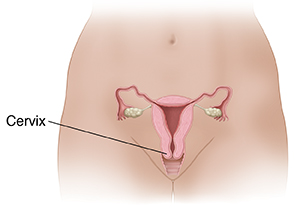Understanding Transcervical Hysteroscopic Sterilization
This procedure is a form of birth control. After it is done, you can no longer have children. You will be sterile.
During this procedure, your healthcare provider uses a tool called a hysteroscope. This long, thin tube has a camera and light on it. The camera sends pictures to a screen. It helps your healthcare provider see inside your womb (uterus).
Along with a hysteroscope, your healthcare provider uses a device loaded with small metal coils. The coils are called micro-inserts. They are made of nickel. They are placed inside your fallopian tubes, where they expand. The coils cause tissue to grow around and in them. This tissue slowly closes up the fallopian tubes. It takes about 3 months. Then your eggs (ova) can no longer travel through the tubes to the uterus to be fertilized.
Why transcervical hysteroscopic sterilization is done
You may choose to have this procedure if you no longer want to have children. It doesn’t call for surgery. Many women find it to be less painful than other choices for sterilization. You may also recover more quickly.
How transcervical hysteroscopic sterilization is done
This procedure is often done at an outpatient facility. You can go home shortly after it is done. During the procedure:
You are given medicine so you don’t feel any pain. It may also make you sleepy.
The healthcare provider puts a speculum into your vagina. It helps him or her see your cervix better.
The provider gently puts the hysteroscope into your vagina. It is moved into your uterus through your cervix.
The provider pumps saline solution into your uterus through the hysteroscope. It inflates your uterus. That helps the provider see the inside of your uterus better.
The provider finds your fallopian tubes using the pictures on the screen.
The provider puts the device with the metal coils into your uterus. The tip of this device is lined up with the opening of one of your fallopian tubes.
Once the device is in place, the provider presses a button on the device. The coils are released into the tube.
The provider checks that the coils are in the right spot.
The provider repeats these steps on the other fallopian tube.
Risks of transcervical hysteroscopic sterilization
Allergic reaction to the nickel coil
Bleeding
Infection
Movement of the coil
Pelvic pain
Pregnancy
Tear in the fallopian tube
Tear in the uterus
